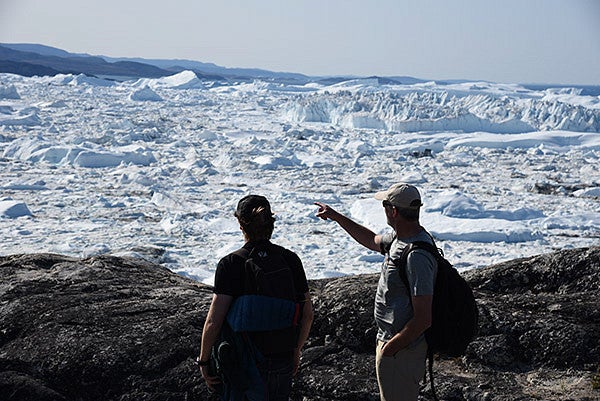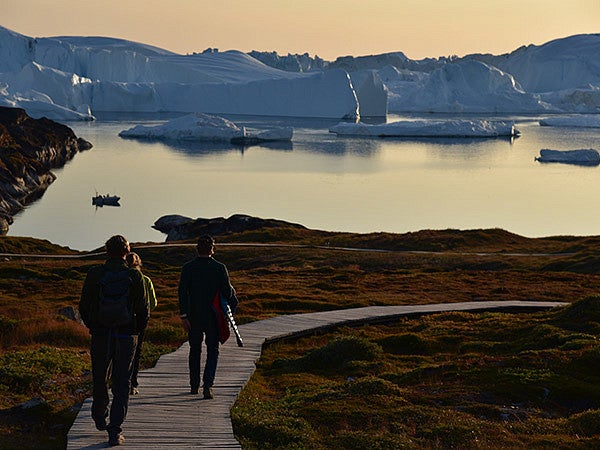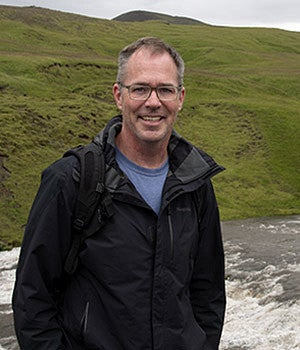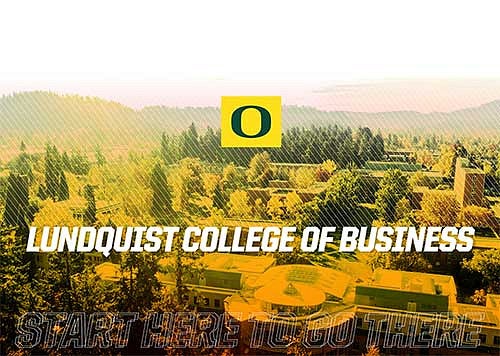
Four Researchers Look at Glacial Melt through Different Lenses to See the Whole Picture
Kristin Schild eyes the iceberg below her as the helicopter she's riding in makes a first pass, surveying the monolith from high above. Circling around for a second look, the helicopter swoops in much lower, barely skimming the surface of the ice. From this distance, Schild can check for erosion and direction of the water flow; both of these give her information about potential ice collapse or an iceberg overturning. The revolutions of the powerful propellers eliminate any other sound.
Grabbing her ice axe tightly when Schild is satisfied that the iceberg is stable, she opens the door of the still-running helicopter that tries to stay in one spot. Secured by ropes and a climbing harness, she lowers herself out of the helicopter and picks around at the ice with the axe, assessing its condition to place a GPS unit. She takes a few more steps while the ropes on her harness are controlled by Casey Shoop, who sits in the helicopter. She does this again and again at various iceberg locations, depending on the data she needs. This action is only part of a larger process to collect the data. It’s called GPS deployment and it’s one of many steps Arctic ice scientists and researchers repeat countless times during data collection on the Greenland ice sheet.


Schild, assistant research professor at the University of Maine and a former postdoctoral fellow at the University of Oregon’s Oceans and Ice Lab, is part of a team of four professors that traveled in August 2019 to study the role of ice in climate change. Unique in its approach, the goal of the trip was to gather information through a multidisciplinary lens and a self-imposed obligation to gather data and conduct research ethically.
The team leaders were comprised of three UO professors who represent three different disciplines; Mark Carey, professor of history and environmental studies and Director of the Environmental Studies Program; Dave Sutherland, professor of earth sciences and head of the Oceans and Ice Lab; and Casey Shoop, professor of literature.


Funded by the National Science Foundation and the University of Oregon’s Williams Fund, the team’s research sought to understand the interplay between ice and society. For Sutherland, an objective was “to directly observe iceberg melt and movement in the Greenland fjords, in order to improve predictions of iceberg melt for global climate models.”
According to Carey, Greenland is a research hot spot “due to its vast ice sheet, but millions of people live in the Arctic so we wanted to understand icebergs as well as people living in Greenland, how they live and interact with ice, and how histories of colonialism shape their realities and even the knowledge we have about the Arctic, the size of the ice sheet and it’s increasingly rapid melting. If the whole ice sheet melted, that would be seven meters of sea level rise.”
The NSF outlines specific guidelines for those who wish to study, collect data, and conduct research across all disciplines, in and outside of the Arctic. The guidelines focus on establishing effective communication with the community where the research is conducted; respecting indigenous knowledge and cultures; and building and sustaining relationships.
This research can include different perspectives that don’t always align with predominant Western media and narratives that hold the environment as most sacred—even above the livelihood of people. Carey heard some of these viewpoints from locals who felt there were benefits of melting sea ice.
“Some people are happy that glaciers are melting back and there are new mineral deposits that are now accessible. We also heard people who are very concerned about seeing how it does impact hunting practices, fishing practices, and access to certain areas. It’s a double-edged sword,” says Carey. “Going in with an open mind allowed us to hear many different voices, which is essential.”
While these concerns may seem head-scratching for some Western audiences, diverging perspectives aren’t new. Carey says he’s spoken with local folks who are simply fed up with questions.
“I’ve talked with people who say, ‘I’m tired of foreigners coming here to ask us about climate change and ice—there are other pressing issues.’”

In Greenland, icebergs are ever present, massive and towering, all in unspoiled shades of white, all in different, organic shapes. They melt, overturn, they move. Some grow curtains of icicles, other have colonies of birds resting on chunks of ice as big as buildings.
Sutherland’s "hard" science background keeps him on the technical side of things. While Schild oversaw data collection, instruments, gear, and safety—he managed logistics for the ship and helicopter rides, lodging, funding, and arranging meetings with local scientists.
Because Sutherland has spent so much time there, he has a routine and a group of people he typically interacts with to accomplish his research goals. He says this trip was different and special.
“Having Mark and Casey along, we ended up talking to different people than I normally do. Typically, I talk to people at the shipping and helicopter ports, then I get on a boat and go. Mark and Casey really engaged with people on the ground in Nuuk (Greenland’s capital city). He and Casey didn’t have an agenda. I’m always kind of driving at research questions I want answered. They were more interested in hearing what was on people’s minds,” explains Sutherland.
For the team, it was imperative to start the research before they even set foot on an iceberg. “Make contacts in advance and communicate beforehand: What are your concerns? How are you thinking about this issue? Also, look for and utilize available sources there–don’t force your own,” says Carey.
That approach means talking to people who represent all corners of local life to get authentic perspectives.
“I felt I had to become responsible, as much as possible, to the archive and ask about the Greenlandic texts and writings, what the artists are doing and how are they thinking about ice,” says Shoop. He says thinking deeply about “colonialism, western representations of the adventure of research, and damaging Anglo-European narratives” also figured into shaping his ice research.
Pushing up against established tropes and highlighting diverse perspectives means centering on communication with local people and organizations; respecting the indigenous assets of culture and knowledge; and working to form and maintain relationships are part of ethical, multi-disciplinary research and data collection. This is what Carey calls, “focusing on societies.”
Sutherland says the benefit of these complementary perspectives—a way of seeing scientific methods and research—opens up a whole new world.
Professor Carey’s mentoring stretches far beyond the classroom, especially via the Glacier Lab. Every year, Clark Honor College students work as his research assistants in the lab, and have co-authored articles with Carey that have been published in journals such as Nature Climate Change and Progress in Human Geography.
Carey was recognized for this mentoring of Clark Honors College students by winning the UO’s 2015 Outstanding Faculty Advisor Award and the 2019 Faculty Research Mentor Award.

Clark Honors College: What do you consider as your top guiding principle when working with students?
Mark Carey: I have three, not one, guiding principles that stand out: independence, inspiration, and community. Independence so students can work alone, find information better, analyze it, organize it, explain it, share their results, etc. My job is to show them the way and help refine their skills and instincts. Inspiration so that they are inspired and driven to do more on their own, to keep learning, to keep digging, to solving puzzles that require days or weeks or months. Inspiration is about helping students find what they really like to do. I also like the inspiration that comes when CHC students I’m mentoring are working alongside and becoming friends with graduate students and postdocs who I also work with.
This is related to the third principle: Building community, which is central to my work with the Glacier Lab. And I always hope it’ll be a community of folks who inspire each other and collaborate and become friends, particularly when it’s a group who would not have found each other otherwise. I always try to create spaces and contexts where people can connect and I just try to get out of the way and let the community roll.
CHC: Do you have a favorite experience that involved students that you are especially proud of or that you thought was wildly successful?
MC: I was involved in one research project in Peru where five professors all brought undergraduate students to Peru and participated in each other’s research. So one day we were on a glacier studying ice movement, another day in the stream measuring water flow, another day doing an inventory of plants in riparian wetlands, another day observing a town meeting, and then, with me, in the National Library analyzing documents and newspapers. The students (including CHC student Kelsey Ward) and professors all learned so much about how to tackle truly interdisciplinary questions of water security, from the ice to the ocean, from subsistence farmers to hydroelectric companies.
While being in the Andes with a CHC student was amazing, it is also a great moment of magic when student research leads to coauthoring a publication. Several weeks ago I presented a conference paper that I’m coauthoring with two CHC students. That paper is the first step toward a published book chapter about efforts to save glaciers in Switzerland, Argentina, and India, which we will submit this fall. So, working with students from the initial idea and light-bulb moment all the way to a published article is also a marvelously rich process for me. But there are many more things, too. This is hard to pin down.
CHC: Mentoring takes a lot of time and effort. And work. What makes it worth it to you? What is it about mentoring that makes it so important?
MC: It’s about giving back and creating opportunities for students that they wouldn’t otherwise get. Professors and mentors helped me get here. I like to give back. There’s also reciprocity in mentoring since the students help me and inspire me, too.
Clark Honors College. What’s in it for you?
When you transfer to Clark Honors College, you open the doors to:
- Unique, tailored curriculum
- An unbendable network of support
- Personalized mentoring
- Focused opportunities, fellowships scholarships
- Small, discussion-based classes
We invite you to sharpen your curiosity, built a platform for life-long learning and enter a community of scholars interested in tackling big (and sometimes small) questions With a dedicated team of faculty and staff who believe in the potential of our students, we work with each and every one to help them reach what is possible.
We are accepting applications from first-year students and rising sophomores for spring 2021 admission December 1, 2020 through January 15, 2021. Email chcadmit@uoregon.edu with any questions.





